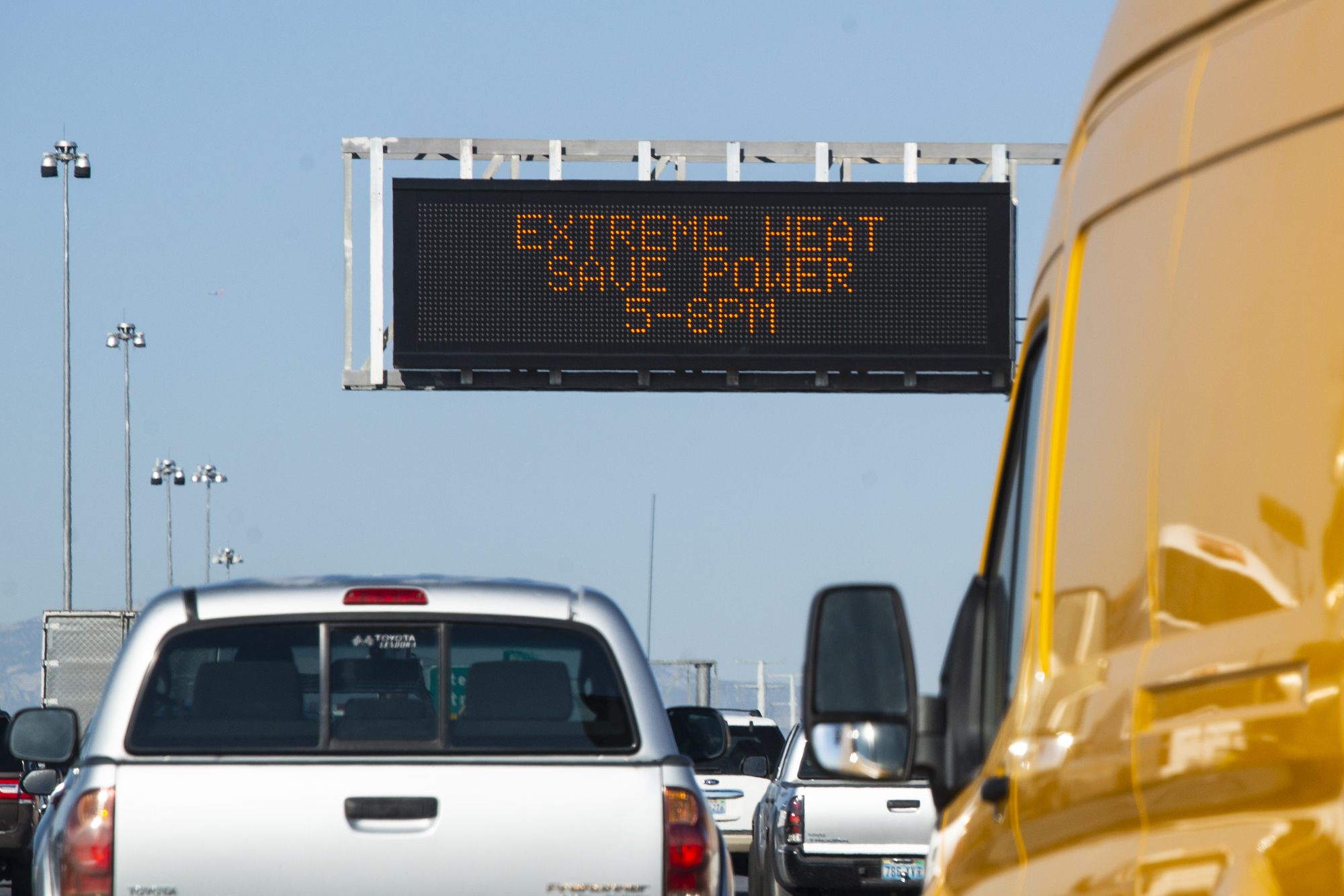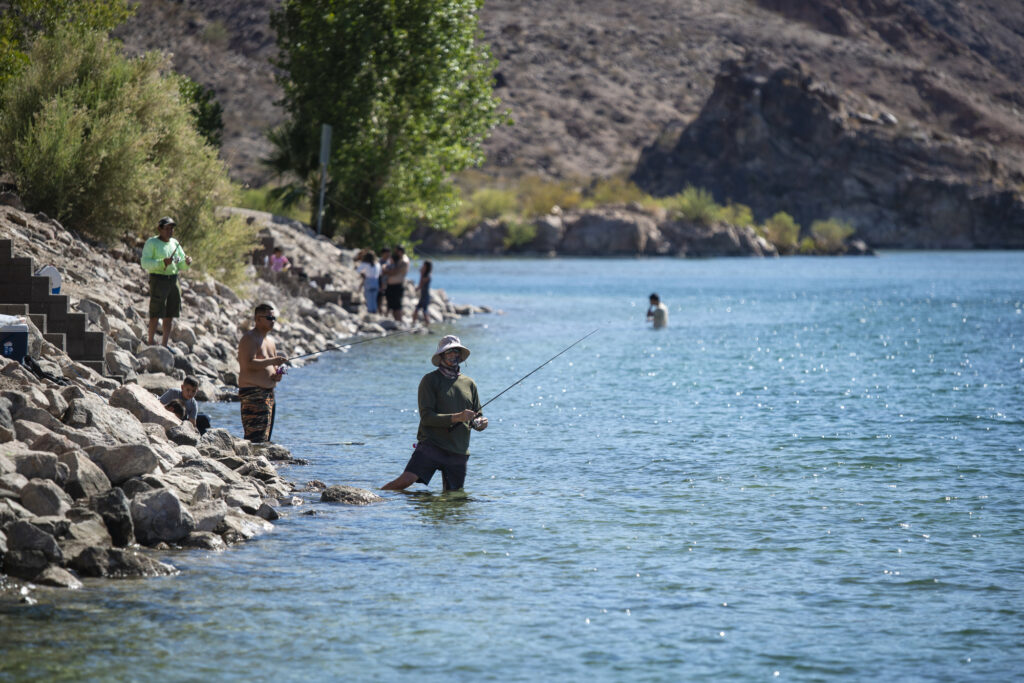The challenges of tracking heat-related illness — and a $2.9 million geothermal sale

Good morning, and welcome to the Indy Environment newsletter.
This week, we spoke with several Clark County officials about some of the challenges tracking heat-related illness, an emerging and often overlooked public health issue that Western states are grappling with. We also look at a geothermal sale on public land.
As always, we want to hear from readers. Let us know what you’re seeing on the ground and how policies are affecting you. Email me with any tips or suggestions at [email protected].
To get this newsletter in your inbox, subscribe here.
Temperatures soared across the state this week. The National Weather Service in Las Vegas issued excessive heat warnings as Reno broke a record Tuesday by a staggering 10 degrees.
Extreme heat ripples through our lives in so many ways. It can make outdoor work more difficult and often more risky. The taxing toll of high temperatures can influence our moods, according to some studies. As residents across the West cranked up their air-conditioning, heat also takes a toll on the grid, with NV Energy and California utilities urging customers to conserve energy use.
But one of the areas where the effects of heat are most pronounced is in public health. As the trend ticks up — with higher temperatures, more days of extreme heat and less cooling off at night — policymakers are increasingly turning their focus to the intersection of heat and health.
Jeff Quinn, who manages the Office of Public Health Preparedness for the Southern Nevada Health District, is with an agency at the center of this issue. The health district has worked with discharge data to track heat morbidity. He said that the agency is “seeing an increase of deaths and heat-related illness in the population,” noting an increase in extreme heat days.
Yet temperatures are only one part of the equation. Access to air-conditioning, age and housing insecurity can influence risk to heat exposure. Moreover, the impact of heat can creep up and amplify more quickly depending on other climate variables, such as humidity. And although the Southwest is known for its dry heat, humidity can increase during summer precipitation events.
Gaps in data, experts have said, pose a significant challenge. The health district, Quinn said, is working closely with other groups as more attention is being paid to the impacts of extreme heat. Yet, he added, “a lot of the data can be siloed in various agencies.”
“We don’t have any one agency that is a repository for heat-related information,” he said.
Quinn cited two efforts that have helped start to provide more coordination within the state and the region. In March, Gov. Steve Sisolak put together an extreme heat planning team, and has highlighted the impacts of heat in a proclamation declaring the first Environmental Justice Day.
In addition, the health district has worked with the regional Southwest Practitioners Adaptation Network, a group for agencies and policymakers to share information and potential solutions.
One of the largest problems in heat data, experts have said, is underreporting. Because heat can amplify existing underlying health issues (not unlike COVID-19), accurately assessing its effect can be difficult. Over the past year, Clark County Coroner Melanie Rouse sought to fix this issue in how her office tracks heat-related and heat-caused fatalities. Rouse, who became the coroner in June 2021, implemented the guidelines a month after assuming her role.
In an interview, Rouse said that she drew on her experience working in Maricopa County, home to the Phoenix metro area and one of the hottest areas of the Southwest. Her goal was to come up with “reliable and trackable information regarding heat deaths” and to develop “a consistent approach to how we are attributing heat.” One example of the approach, she said, is to make sure investigators collect information from the scene to help better understand the risks of exposure that might have contributed to a heat-related fatality. Was the A/C broken?
These details and statistics, she said, are vital for policymakers, helping the county “determine things like high-risk areas” and where to locate cooling stations. Last year, the county reported 250 fatalities involving heat. So far this year, according to a county spokesperson, there have been 74 deaths involving heat, though several cases are still pending, so the data can lag.
Quinn stressed education as an equally important part of the health district’s effort to address extreme heat. The health district posts information about heat exhaustion and heat stroke.
While he said it is important to stay hydrated, it’s not solely about drinking water. Maintaining a healthy electrolyte balance is also important, as is watching for the signs of overexposure to heat. These can include headaches and dizziness. If you’re outside and not sweating on a hot day, Quinn said, that can be another sign that your body is retaining heat in an unhealthy way.
As Quinn puts it, it is important to approach hot days with an “understanding that we’re all susceptible to heat and really we need to plan our days accordingly.”

Here’s what else I’m watching this week:
A large geothermal sale on public land in Nevada: For years, Nevada has pitched itself as a central location for geothermal energy. Unlike solar and wind, geothermal energy that harnesses the heat below the Earth’s surface can produce electricity around-the-clock — without producing harmful greenhouse-gas emissions. As electric utilities, cities and states across the U.S. commit to deep decarbonization, policymakers have eyed geothermal as an important piece in the puzzle. Along with large-scale batteries, geothermal can help fill the renewable energy gap created when the sun is not shining on solar panels and wind is not blowing turbines. Now there is a push to build projects.
The most recent data point: A federal geothermal lease auction that generated more than $2.9 million. The U.S. Bureau of Land Management, which oversees more than 65 percent of the land within Nevada, regularly auctions parcels of land for energy projects. These auctions are an initial step, giving developers a lease to use public land.
The roughly $2.9 million in high bids was for 66 parcels encompassing nearly 200,000 acres of federal public land. More than 20 companies participated in the auction last week. Notably, they included Reno-headquartered geothermal developer Ormat and NV Energy. Others included Chevron and Kirkwood Oil and Gas. While not a record for geothermal leasing in Nevada (one lease sale in 2009 generated about $8.9 million), the roughly $2.9 million sale remains on the higher side.
- Even with a federal lease in hand, many geothermal projects face an uphill battle. The projects require upfront capital for drilling and involve certain risks as tapping into a geothermal source requires exploring a blind resource that is hidden underground. There are also permitting challenges. Many geothermal sources exist near springs or tap into groundwater systems that support unique ecosystems and species, or conflict with other land uses. Such is the case with the Dixie Valley toad, a species that was granted emergency endangered protection earlier this year and faces a threat from geothermal development.
Interior Secretary Deb Haaland held a roundtable discussion with Indigenous leaders and activists pushing the federal government to designate Avi Kwa Ame as a national monument. E&E News’ Jennifer Yachnin reported on the visit, which other top federal officials attended.
NV Energy calls on customers to conserve as heat hits the Western grid: The utility asked customers to cut back on their energy usage Tuesday through Thursday to provide some relief to the Western grid, under significant strain with extreme temperatures driving up demand.
“The state’s largest utility firm, NV Energy, is applying to merge its two electric subsidiaries into one entity, which could impact how the company finances projects in the future and how the company is regulated,” the Las Vegas Review-Journal’s Sean Hemmersmeier reports.
Important reporting about water and inequality from the L.A. Times’ Hayley Smith, who writes “...the number of dry wells in California has increased 70% since last year, while the number of Californians living with contaminated drinking water is at nearly 1 million. The majority of those people live in low-income communities and communities of color, state data show — and experts say heat, drought and climate change are only making those inequities worse.”
The Arizona Republic’s Debra Utacia Krol investigates the high price of demand for sage: “It's being poached by the ton from tribal lands, public lands and even some plots of privately-owned land, decimating ecologies and Native cultures in Southern California and Baja California.”
Negotiations over the Colorado River’s future continue — as comments for long-term solutions begin to trickle in. There appears to be a consensus that the states reliant on the Colorado River must act to slow the decline of Lake Mead and Lake Powell, two major water reservoirs at record low levels. But how that gets done, and on whose terms, remains an open question for water users across the Southwest. All eyes are on Arizona and California, which together account for most of the water taken out of Lake Mead. Deliberations regarding those cuts come as policymakers, activists and water managers submit their comments about what a long-term future might look like, an initial step in renegotiating operating guidelines for the river.
- California braces for painful water cuts, The Los Angeles Times’ Ian James reports.
- From The Arizona Daily Star’s Tony Davis: Arizona water chief seeks federal action
- The Salt Lake Tribune’s Zac Podmore and The Arizona Republic’s Brandon Loomis both wrote in-depth pieces about Lake Powell.
- As Western water managers seek a deal on short-term cuts, they are also turning their attention toward what a more sustainable future might look like. Colorado River expert John Fleck wrote a post about what’s next for the negotiations — and he shared an argument that he developed with Eric Kuhn, the former general manager of the Colorado River Water District, and Jack Schmidt, a watershed scientist at the University of Utah.
After the fire: Last year, the Dixie Fire devastated local communities in California’s rural Plumas County, north of Reno. But communities are working to recover from the disaster, layered on top of another one — COVID-19. High Country News’ Colleen Hagerty looks at how one school administrator in Plumas County has helped shepherd her district through the pandemic and devastating fire.
Wildland firefighters and mental health: Excellent Wall Street Journal article by Dan Frosch and Jim Carlton on the impacts of firefighting on mental health (with photos by David Calvert). This line stuck out: “Crews are enduring longer deployments as they combat more destructive fires that behave less predictably. Wildland firefighters said the transition back home has become more jarring. Some said it shattered relationships. Others turned to substance abuse.”
Federal regulators created and released a mobile app with information about mine safety.
Wild horse (sculptures) at Burning Man. More from the Reno Gazette Journal’s Amy Alonzo.
- And more wildlife news: Moose are moving into northeastern Nevada, Alonzo reports.
